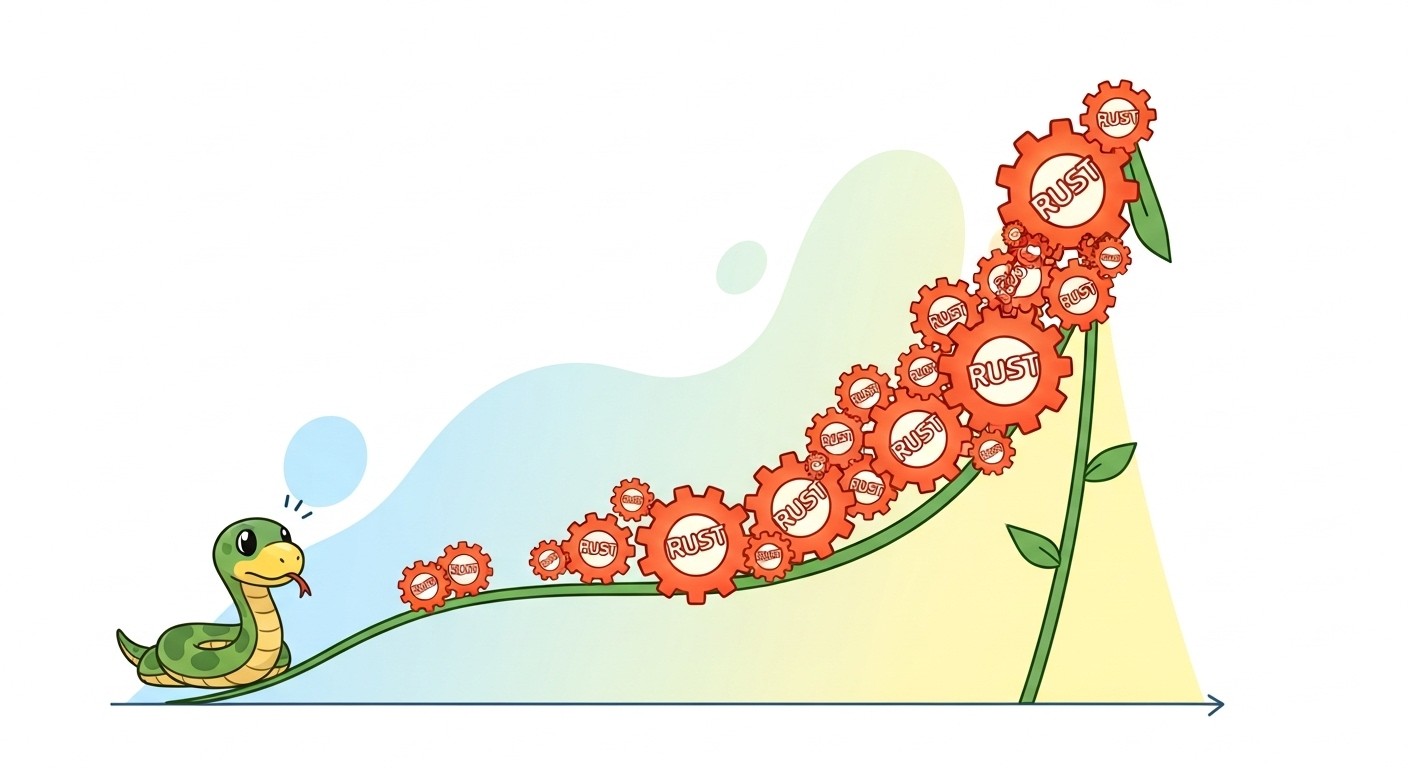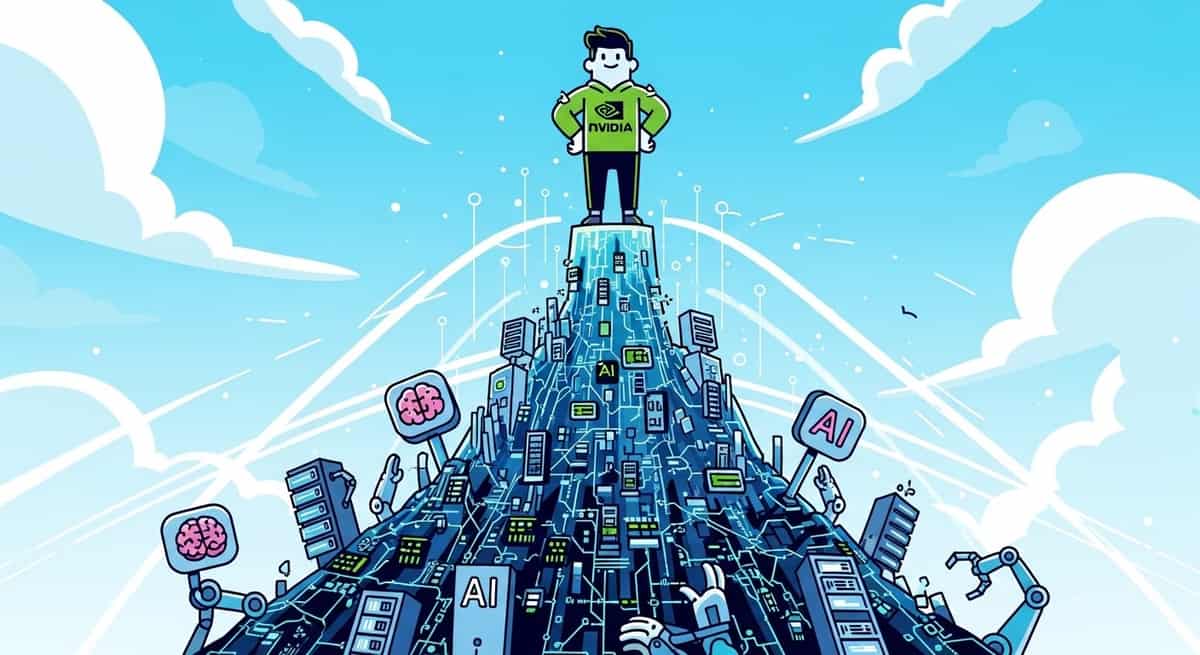Programming Language Wars 2025: Rust vs Python Showdown

The programming landscape is experiencing its most dramatic shift in years. As we move through 2025, traditional language hierarchies are being challenged by newcomers that promise better performance, safety, and developer experience. The latest industry data reveals surprising trends that are reshaping how developers choose their tools.
Rust has emerged as the unexpected champion in Python's ecosystem, while TypeScript continues its march toward web development dominance. Meanwhile, Go maintains its stronghold in backend services, and newer languages like Kotlin and Swift expand beyond their original domains. These aren't just minor adjustments, they represent fundamental changes in how we think about programming language selection.
Link to section: The Rust Revolution: More Than Just HypeThe Rust Revolution: More Than Just Hype
The most striking development in 2025 has been Rust's explosive growth in unexpected areas. What started as a systems programming language has become "Python's performance co-pilot," with adoption in Python binary extensions jumping from 27% to 33% in just one year[19]. This growth isn't happening in isolation, it reflects a broader industry recognition that performance and safety don't have to be mutually exclusive.
The Python Language Summit of 2025 revealed that somewhere between one-quarter and one-third of all native code being uploaded to PyPI for new projects now uses Rust[19]. This shift represents more than just a trend; it's a fundamental change in how Python developers approach performance-critical components. Projects like Polars for data science and Pydantic for data validation have demonstrated that Rust-powered Python libraries can deliver dramatic performance improvements without sacrificing the Python developer experience.
What makes this particularly interesting is that Rust isn't replacing Python, it's enhancing it. Developers are discovering that they can maintain Python's productivity advantages for application logic while leveraging Rust's performance characteristics for computationally intensive operations. This hybrid approach is becoming increasingly common in production environments where both developer productivity and runtime performance matter.
The ecosystem around Rust-Python integration has matured rapidly. Tools like PyO3 make it straightforward to create Python modules in Rust, while projects like maturin handle the complex packaging and distribution challenges. This infrastructure development has lowered the barrier to entry for Python developers who want to experiment with Rust for performance-critical components.
Link to section: TypeScript's Unstoppable MarchTypeScript's Unstoppable March
While Rust makes headlines in the systems programming world, TypeScript has quietly become the default choice for serious JavaScript development. The language's growth in 2025 reflects developers' increasing demand for type safety and better tooling, especially as applications grow larger and more complex.
TypeScript's success isn't just about catching bugs, it's about enabling better development workflows. Modern IDEs provide sophisticated autocompletion, refactoring tools, and navigation features that simply aren't possible with plain JavaScript. For teams working on large codebases, these productivity gains compound over time, making TypeScript adoption almost inevitable.
The framework ecosystem has embraced TypeScript wholeheartedly. Popular frameworks like Angular and React now assume TypeScript as the primary development language, with JavaScript feeling like the legacy option. Even backend frameworks for Node.js increasingly ship with TypeScript-first documentation and examples.
What's particularly noteworthy is how TypeScript has evolved beyond just "JavaScript with types." Features like template literal types, conditional types, and advanced inference capabilities have created a sophisticated type system that rivals traditional statically-typed languages. This evolution has attracted developers from languages like Java and C# who appreciate the type safety without sacrificing JavaScript's flexibility.

Link to section: Go's Steady Enterprise DominanceGo's Steady Enterprise Dominance
While newer languages grab attention, Go continues to demonstrate why it became the go-to choice for backend services and cloud infrastructure. Google's language has found its sweet spot in microservices architecture, where its simplicity, built-in concurrency support, and fast compilation times provide clear advantages.
The language's design philosophy of explicit simplicity has proven remarkably prescient. While other languages add increasingly complex features, Go's deliberate limitations force developers to write clear, maintainable code. This approach has made Go particularly popular in enterprise environments where code maintainability and team productivity matter more than cutting-edge language features.
Go's standard library deserves special recognition. The built-in HTTP server, JSON handling, and testing framework provide everything needed for most backend services without external dependencies. This "batteries included" approach reduces complexity and security risks while improving deployment reliability.
Container orchestration platforms like Kubernetes and Docker are written in Go, cementing its position in the cloud-native ecosystem. As more organizations adopt microservices architectures, Go's advantages become increasingly apparent. The language's garbage collection is tuned for server workloads, and its memory usage patterns work well in containerized environments.
Link to section: Mobile and Cross-Platform EvolutionMobile and Cross-Platform Evolution
The mobile development landscape has seen significant changes as Kotlin and Swift expand beyond their original platforms. Kotlin Multiplatform has gained traction among organizations looking to share code between Android and iOS applications while maintaining native performance characteristics.
Swift's evolution has been particularly interesting. Originally designed for iOS development, Swift has expanded into server-side development with frameworks like Vapor gaining popularity. Apple's investment in Swift for server-side development suggests a long-term strategy to create a unified development experience across all Apple platforms.
The cross-platform story isn't just about mobile anymore. Flutter continues to gain ground as a truly multi-platform framework, supporting mobile, web, and desktop development from a single codebase. While debate continues about performance and platform-specific features, Flutter's productivity advantages are undeniable for many types of applications.
React Native remains strong in the JavaScript ecosystem, offering web developers a path to mobile development without learning new languages. The recent architectural improvements in React Native have addressed many of the performance concerns that plagued earlier versions.
Link to section: The Performance vs Productivity DebateThe Performance vs Productivity Debate
The language trends of 2025 reveal a fundamental tension between performance and productivity that's being resolved in interesting ways. Rather than choosing one over the other, developers are increasingly adopting hybrid approaches that optimize for different characteristics in different parts of their applications.
The rise of AI-powered development tools has changed this equation somewhat. Code generation and intelligent assistance can reduce the productivity gap between high-performance languages like Rust and more accessible options like Python or JavaScript. When an AI assistant can help write complex Rust code, the traditional argument about development speed becomes less compelling.
Memory safety has become a critical factor in language selection, especially for systems programming and security-sensitive applications. Rust's ownership model provides memory safety without garbage collection overhead, making it attractive for applications where both performance and security matter. This has led to increasing adoption in web servers, databases, and cryptographic libraries.
The emergence of Rust-based web frameworks like Axum and Leptos suggests that the web development world might be ready for a more performance-oriented approach. While these frameworks haven't reached the maturity of established options like Express.js or Django, they offer compelling performance advantages for high-throughput applications.
Link to section: New Tooling Transforms Development ExperienceNew Tooling Transforms Development Experience
The programming language landscape isn't just changing because of the languages themselves, the tooling ecosystem has evolved dramatically. New type checkers for Python, written in Rust, offer dramatically faster feedback cycles. Tools like ty from Astral and Pyrefly from Meta provide extremely fast type checking and language server protocols[19].
This trend of Rust-powered developer tools extends beyond type checking. Build tools, linters, and formatters written in Rust are replacing slower implementations in other languages. The performance gains are significant enough to change development workflows, enabling real-time feedback that was previously impractical.
Language servers have become crucial for modern development experience. The Language Server Protocol (LSP) has standardized how editors and IDEs communicate with language-specific tools, making it easier for new languages to provide excellent developer experience across different editors.
Package managers have also seen innovation. Tools like Bun for JavaScript and Cargo for Rust have set new expectations for dependency management speed and reliability. These improvements have a cascading effect on developer productivity that goes beyond the languages themselves.
Link to section: Industry Adoption PatternsIndustry Adoption Patterns
Enterprise adoption patterns reveal interesting insights about language selection criteria. While startups might choose languages based on performance or developer preference, enterprises prioritize factors like long-term support, talent availability, and integration with existing systems.
Java remains dominant in enterprise environments despite not appearing in many "hot new language" discussions. The JVM ecosystem's maturity, extensive tooling, and massive talent pool make it difficult to displace. However, even Java is evolving, with projects like Project Loom and improvements to garbage collection keeping it competitive.
The financial services industry has shown particular interest in Rust for performance-critical trading systems and risk management applications. The combination of memory safety and performance makes Rust attractive for applications where bugs can have significant financial consequences.
Cloud providers are influencing language adoption through their service offerings. AWS Lambda's support for different runtimes, Google Cloud's language-specific optimizations, and Azure's development tools all shape which languages teams choose for new projects.
Link to section: Future Implications and RecommendationsFuture Implications and Recommendations
The programming language trends of 2025 suggest several important implications for developers and organizations. First, the era of single-language applications is ending. Modern applications increasingly use multiple languages optimized for different tasks, with tools and frameworks making integration easier than ever.
For individual developers, the key is understanding which languages excel in which domains rather than trying to pick a single "best" language. Python remains excellent for rapid prototyping and data analysis, but Rust might be the better choice for performance-critical components. TypeScript provides the best of both worlds for web development, while Go offers simplicity and reliability for backend services.
Organizations should focus on building diverse language capabilities within their teams rather than standardizing on a single technology stack. The most successful projects often combine languages strategically, using each one's strengths while minimizing weaknesses through good architecture.
The tooling ecosystem will continue to be a major factor in language adoption. Languages with excellent IDE support, fast build tools, and comprehensive package managers have significant advantages over those with weaker tooling. This suggests that language communities should prioritize developer experience alongside language features.
Looking ahead, the integration between AI development tools and programming languages will likely accelerate. Languages that work well with AI assistants may gain advantages in developer productivity, potentially changing the traditional performance-versus-productivity tradeoffs that have historically driven language selection.
The programming language landscape of 2025 reflects a maturing industry that increasingly values pragmatic solutions over ideological purity. Rather than searching for one language to rule them all, successful developers and organizations are learning to use the right tool for each specific job, creating more robust and efficient software systems in the process.

